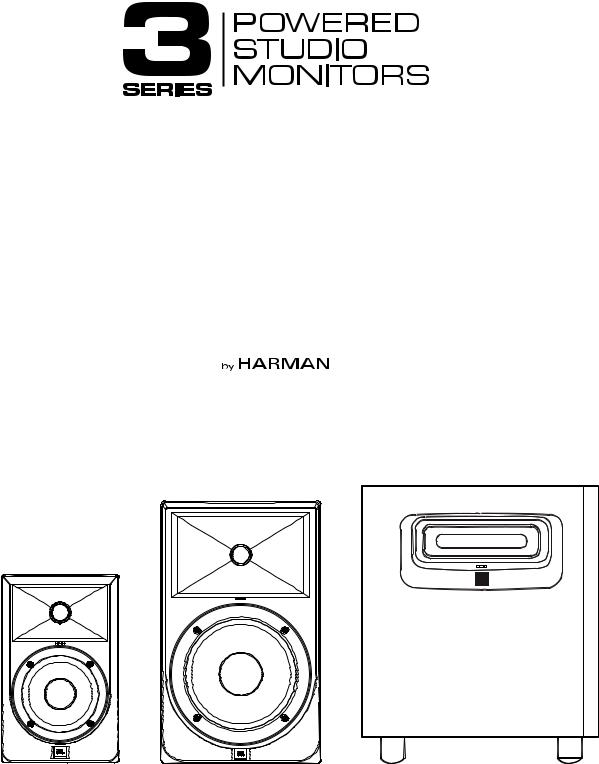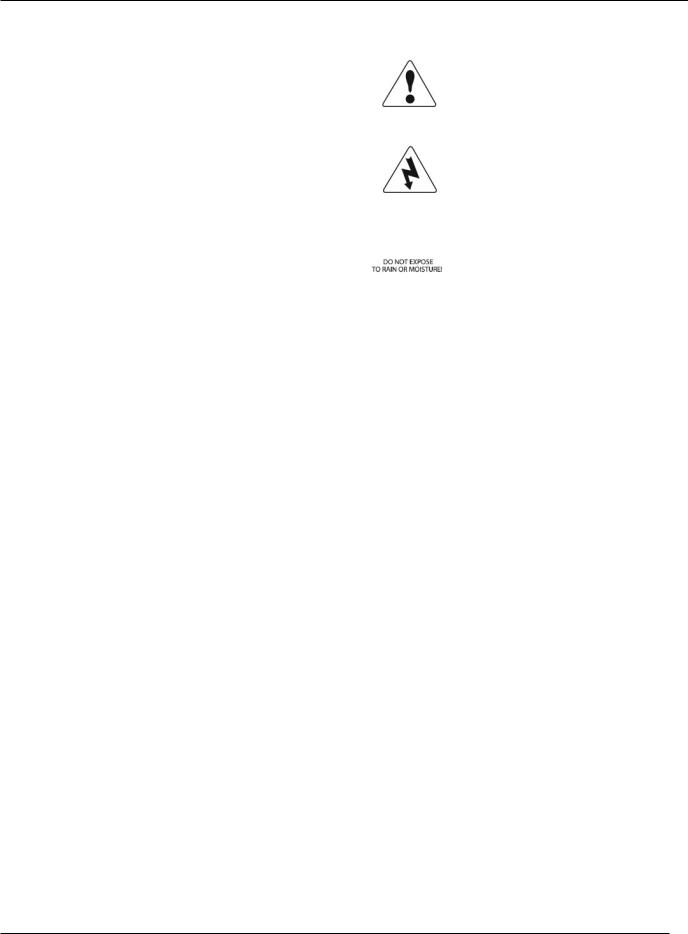JBL LSR305, LSR308, LSR310S User Manual

Owners Manual
|
|
|
|
|
|
|
|
|
|
|
|
|
|
|
|
|
|
|
|
|
|
|
|
|
|
|
|
|
|
|
|
|
|
|
|
|
|
|
|
|
|
|
|
|
|
|
|
|
|
|
|
|
|
|
|
|
|
|
|
|
|
|
|
|
|
|
|
|
|
|
|
|
|
|
|
|
|
|
|
|
|
|
|
|
|
|
|
|
|
|
|
|
|
|
|
|
|
|
|
|
|
|
|
|
|
|
|
|
|
|
LSR305 |
|
LSR308 |
|
|
|
LSR310S |
|||
5" Powered |
8" Powered |
10" Powered |
Studio Monitor |
Studio Monitor |
Studio Subwoofer |

Thank you for your purchase of JBL 3 Series Studio Monitors
To receive important information as it becomes available please take a moment to register your 3 Series speakers now.
Click the link or go to www.jblpro.com/3series
2

Section 1: Important Safety Instructions
1.Read these instructions.
2.Keep these instructions.
3.Heed all warnings.
4.Follow all instructions.
5.Do not use this apparatus near water.
6.Clean only with dry cloth.
7.Do not block any ventilation openings. Install in accordance with manufacturer’s instructions.
8.Do not install near any heat sources such as radiators, heat registers, stoves or other apparatus that produce heat.
9.Do not defeat the safety purpose of the grounding type plug. A polarized plug has two blades with one wider than the other. A grounding type plug has two blades and a third grounding prong. The wide blade or the third prong is provided for your safety. If the provided plug does not fit into your outlet, consult an electrician for replacement of the obsolete outlet.
10.Protect the power cord from being walked on or pinched particularly at plugs, convenience receptacle and the point where the power cord connects to the apparatus.
11.Only use attachments/accessories specified by the manufacturer.
12.Unplug this apparatus during lightning storms or when unused for long periods of time.
13.Refer all servicing to qualified service personnel. Servicing is required when the apparatus has been damaged in any way, including: power-supply cord or plug is damaged, liquid has been spilled or objects have fallen into the apparatus, the apparatus has been exposed to rain or moisture, does not operate normally, or has been dropped.
14.The appliance coupler of the power supply cord is used as the ultimate disconnect device from the mains. The appliance coupler shall remain readily operable.
15.The apparatus shall be connected to mains socket outlet with a protective earthing connection.
WARNING:
•To reduce the risk of fire or electrical shock, do not expose the apparatus to rain or moisture.
•The apparatus shall not be exposed to dripping or splashing and no objects filled with liquids, such as vases, shall be placed on the apparatus. As with any electronic product, use care not to spill liquids into any part of the system. Liquids can cause a failure and/or a fire hazard.
Explanation of Graphic Symbols
The exclamation point within an equilateral triangle is intended to alert the users to the presence of important operating and maintenance (servicing) instructions in the literature accompanying the product.
The lightning flash with the arrowhead symbol, within an equilateral triangle, is to alert the user to the presence of insulated “dangerous
voltage” within the products enclosure that may be of sufficient magnitude to constitute a risk of electric shock to humans.
CAUTION: TO REDUCE THE RISK
OF ELECTRONIC SHOCK - DO NOT
REMOVE COVER. NO USER SERVICEABLE
PARTS INSIDE. REFER SERVICING TO
QUALIFIED PERSONNEL. DO NOT EXPOSE
THIS APPARATUS TO RAIN OR MOISTURE.
Any changes or modifications not expressly approved by the party responsible for compliance could void the user's authority to operate the equipment.
This equipment has been tested and found to comply with the limits for a class B digital device, pursuant to part 15 of the FCC Rules. These limits are designed to provide reasonable protection against harmful
interference in a residential installation. This equipment generates, uses and can radiate radio frequency energy and, if not installed and used in accordance with the instructions, may cause harmful interference to radio communications. However, there is no guarantee that interference will not occur in a particular installation.
If this equipment does cause harmful interference to radio or television reception, which can be determined by turning the equipment off and on, the user is encouraged to try to correct the interference by one or more of the following measures:
•Reorient or relocate the receiving antenna.
•Increase the separation between the equipment and receiver.
•Connect the equipment into an outlet on a circuit different from that to which the receiver is connected.
•Consult the dealer or an experienced radio/ TV technician for help.
CAN ICES-3(B)/NMB-3(B)
3

Contents
Important Safety Instructions...................................................................................... |
3 |
Introduction .............................................................................................................. |
5-6 |
Setting Up Your System............................................................................................... |
6 |
What's Included?.................................................................................................... |
6 |
Unpacking.............................................................................................................. |
6 |
Placement............................................................................................................... |
7 |
Audio Connections................................................................................................. |
8 |
Power Connections................................................................................................ |
8 |
Making Sound........................................................................................................ |
9 |
LSR305 and LSR308 Powered Studio Monitors |
|
Front and Rear Views........................................................................................... |
10 |
Input Panel............................................................................................................ |
11 |
Audio Connections............................................................................................... |
11 |
LSR310S Powered Studio Subwoofer |
|
Front and Rear View ............................................................................................ |
12 |
Input Panel............................................................................................................ |
13 |
Audio Connections............................................................................................... |
13 |
Setting Subwoofer Level ..................................................................................... |
14 |
Placement and Polarity......................................................................................... |
14 |
XLF, Extended Low Frequency Setting, |
|
Crossover Settings and Bass Management......................................................... |
14 |
Surround Sound and .1 LFE Channel................................................................... |
15 |
Systems Connections .......................................................................................... |
16-17 |
Trouble Shooting......................................................................................................... |
18 |
Specifications.............................................................................................................. |
19 |
JBL Service Contact Information.............................................................................. |
20 |
Product Warranty Information .................................................................................. |
21 |
4

Section 2: Introduction
Congratulations on your purchase of JBL Professional 3 Series Studio Monitors. These studio monitors and Subwoofer meet JBL’s high standards for accuracy and long-term reliability in demanding professional applications. All 3 Series models incorporate JBL Professional transducer and network technologies to provide accurate frequency response, exceptional low frequency extension and high SPL capability. JBL LSR Linear Spatial Reference design ensures greater accuracy at the mix position in acoustically varied work spaces and production environments. Additionally, each speaker is equipped to interface with a range of signal
sources including high-output professional equipment.
JBL LSR Linear Spatial Reference Design
Because listening environments vary, JBL designed the 3 Series system using LSR Linear Spatial Reference design criteria that improve accuracy at the listening position in a broad range of rooms. The key to accuracy is ensuring not just the on-axis sound, but also the reflected sound reaching the mix position is neutral. While most manufacturers take only a single on-axis measurement of the speaker’s performance, Linear Spatial Reference design criteria requires 72 measurements, 360 degrees around the speaker, yielding 1,200 times more data. This data is used in the design of critical system components, enabling JBL to engineer complete systems that deliver smooth off-axis response. The result: clear accurate sound at the listening position in any room.
3-Series Image Control Waveguide
JBL’s revolutionary Image Control Waveguide gives the LSR305 and LSR308 remarkable imaging, a wide sound-stage, and a solid “phantom center.” Subtle details can be heard, even in a dense mix. As an added benefit, incorporating this waveguide, 3-Series models give you a broad “sweet-spot” in your work space, so you don’t have to be seated directly in front of the speakers to hear accurate, natural and open sound.
3 Series models include a range of features to meet the needs of demanding audio production applications. LSR305 and LSR308 models include:
•Low frequency magnetically-shielded transducers, equipped with 1.5" voice coils and robust motor structures to provide excellent low frequency performance. By reducing thermal-related effects, the 3 Series Studio Monitors and Subwoofer sound the same at low, medium and high levels. The woofers are magnetically shielded to prevent interference with magnetically sensitive displays and equipment. The woofer’s self-repairing dust dome is resistant to dents caused by fingers or external objects.
•JBL’s Patented Slip Stream™ low frequency port design that works in concert with the woofer to produce deep bass response at all playback levels. The double-flared shape of the port is precisely engineered for greater lowfrequency extension and reduced turbulence.
•Bi-amplified Design with individual power amplifiers for the Low Frequency and High Frequency Transducers. The design utilizes efficient high-output Class D integrated power amplifiers to provide high SPL
(Sound Pressure Level) for demanding production applications.
•Soft dome magnetically-shielded high-frequency transducers with optimally damped materials to improve transient response and minimize distortion. By reducing distortion in the lower operating range, where the ear is most sensitive, these transducers reduce ear fatigue.
•Balanced XLR and 1/4" connectors, a dented level attenuator to allow interface to a broad range of signal sources. The +4 dB / -10 dB input sensitivity switch allows connection of the speakers to high-output professional equipment without danger of input overload.
•High Frequency and Low Frequency Trim controls in the LSR308 and LSR305 allow adjustment of frequency response to preference, or to compensate for acoustically reflective or absorptive listening environments.
Producing extended low frequency into the 20 Hz region, the LSR310S is the perfect match for the LSR305 and LSR308 Studio monitors. The LSR310S feature set includes:
•A custom designed down-firing, High-Excursion 10" woofer with an additional bucking magnet.
•200 Watts Class D Power Amplifier with abundant output and dynamic headroom for the most demanding production styles.
5

•Patented Slip Stream Port – The patented JBL low frequency port design works in concert with the 3 Series woofer for accurate bass response at all playback levels.
•A detented volume control makes it easy to balance of the LSR310S in your studio monitor system.
•Balanced XLR and 1/4" inputs and XLR outputs you can add the LSR310S to any studio monitor system to extend its low frequency performance, or use it as the “.1” LFE Channel in a surround sound system.
•The -10 dBV/+4 dBu sensitivity switch ensures compatibility with a broad range of signal sources, allowing you to connect the LSR310S to high-output professional equipment without any danger of input overload.
•Three Crossover settings: 80 Hz, XLF, External
•The 80 Hz setting implements high and low pass filters to create a seamless blend of the LSR310S with JBL’s LSR305 or LSR308 studio monitors or models from other manufacturers.
•The external setting bypasses all filtering, allowing use of an external crossover.
•The special XLF setting activates a 120 Hz High Pass Filter in conjunction with a low frequency tuning that approximates the tuning used in club playback systems. Using this setting, the bass output more than doubles.
•A protective limiting circuit allows the subwoofer to operate continuously at full output without failure.
JBL Professional Reliability
Prior to becoming a production-ready design, each 3 Series model is subjected to JBL’s tough 100-hour power test, in which the speaker is required to play continually at full output for 100 hours without failure. This demanding test ensures your 3 Series speakers will deliver years of reliable performance. To get the most out of your JBL 3 Series, please review this owner’s manual and keep it on hand for future reference. Also, please register your new speakers at www.jblpro.com/registration.
Section 3: Setting Up Your System
Each 3 Series box includes the following items:
•One 3 Series Studio Monitor or Subwoofer
•One Power Cord
•Quick Set Up Guide
•LSR308 and LSR305 include peel-off rubber pads
Unpacking
When removing a speaker from its packaging, we recommend the following procedure, which will prevent damage of the high frequency transducer located near the top of the cabinet on the front of the speaker: LSR305 and LSR308:
•Remove the outer shipping carton, if one exists.
•Place the inner carton on the floor with the top facing upwards.
•Open the top of the box.
•Without removing the internal packaging end-cap, gently rotate the carton so the open end rests on the floor and the bottom of the carton is facing you.
•Gently lift the carton allowing the speaker and protective end-cap to slide out of the carton and remain on the floor.
•Save the cartons and use the above procedure in reverse when you want to repack the units for shipment.
6

LSR310S Subwoofer - The subwoofer weighs 19 kg (42 lbs.) Unpacking the subwoofer does not require you lift the subwoofer. However, you will need to rotate the subwoofer in the carton. If you are unable to perform the following steps without assistance, please request help from another person.
•Remove the outer shipping carton, if one exists.
•Place the carton on the floor with the bottom facing upward.
•Open the bottom flaps of the carton and remove any protective packing materials from the bottom of the subwoofer. Open the bag that protects subwoofer, exposing the subwoofer’s four feet.
•Gently rotate the carton so the bottom of the carton is facing the floor and the four feet of the subwoofer are in contact with the floor.
•Gently lift the carton allowing the subwoofer and protective packing materials to slide out of the carton and remain on the floor.
•Remove the protective packing materials and documentation from the top of the subwoofer. Save the cartons and use the above procedure in reverse when you want to repack the units for shipment.
Placement
3 Series speakers are designed to deliver exceptional imaging in any room. To get the most out of your speakers, follow these recommendations:
•Locate the four self-adhesive rubber pads supplied with LSR305 and LSR308 speakers. Position and attach these to the bottom surface of the speaker close to each corner.
•Position each LSR305 and LSR308 speaker in a vertical orientation with the tweeter on the top. Vertical orientation eliminates phase shift and cancellation of frequency response that occurs when the distance of the woofer to the ear is different from the distance of the tweeter to the ear.
•Angle the speakers so the high-frequency transducer in each speaker is aimed directly towards the ear of the listener.
•Ideally, LSR305 and LSR308 Series speakers should be placed on suitable speaker stands, rather than on the work surface. This will reduce resonance and deterioration of low frequency performance that occurs through the speaker’s mechanical coupling with the work surface.
•For optimum imaging, the left speaker and the right speaker should be placed symmetrically in the room, so each speaker is the same distance from adjacent walls and reflective surfaces.
•The speakers should be placed so the position of the listener and the two speakers form an equilateral triangle. Adjusting the distance between the speakers will affect the quality of bass heard at the listening position. You can experiment with speaker placement to find the placement that produces the preferred bass response, imaging and when listening to stereo material, produces a strong “phantom” center in which vocals and some instruments seem to originate from a point between speakers.
•The listening distance can be determined according to your preference, the acoustics of your room and the maximum SPL (Sound Pressure Level) you want to hear at the listening position. You can find the speaker’s maximum SPL at 1 Meter in the Specifications Section at the end of this manual. Each doubling of listening distance will reduce the SPL at the listening position by 6 dB in an acoustically absorptive room, but only 3 or 4 dB in an acoustically reflective room.
LSR310S Subwoofer placement: The low frequency driver of the 310S is mounted on the bottom panel of the subwoofer. Before placing the subwoofer, make sure the position on the floor is free of any large objects that can interfere with or damage the woofer. In a stereo system, The LSR310S Subwoofer should be placed directly on the floor, located between the Left and Right Speakers. In a surround sound system, the subwoofer can be located between the Left and Center or between the Right and Center channel Speakers. The distance of the subwoofer from the listening position can be adjusted to produce the optimum balance of bass in the system. Placing the subwoofer close to a wall or in a corner generally will increase the amount of bass heard in the room. Experiment to determine the Subwoofer placement that produces the best balance and quality of bass in the system.
7
